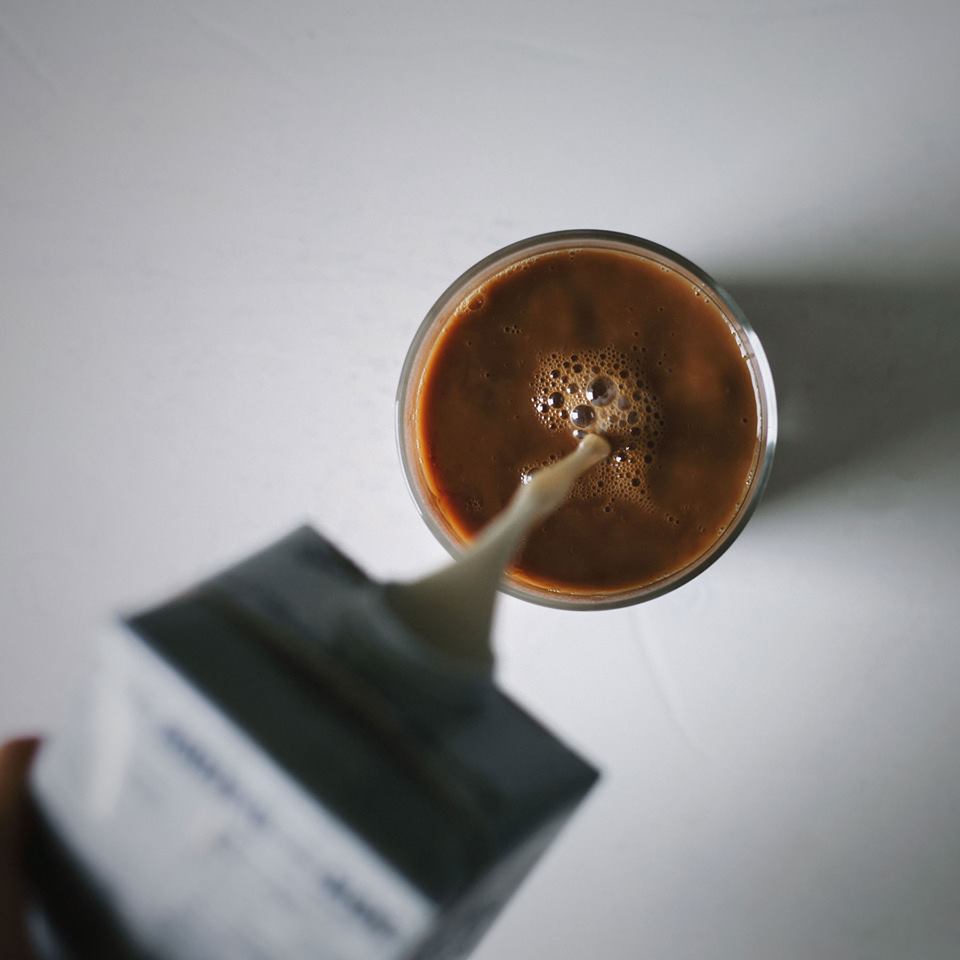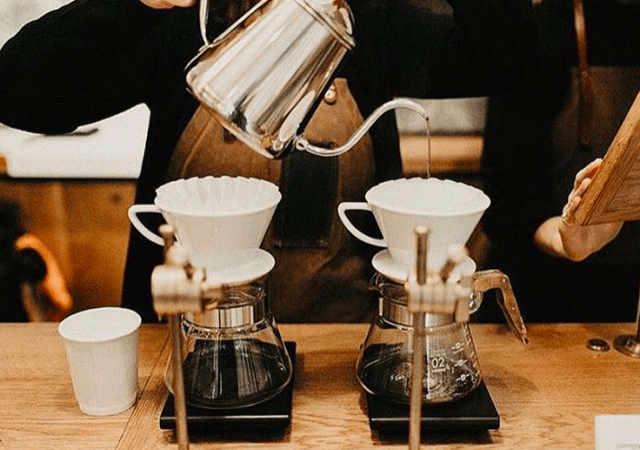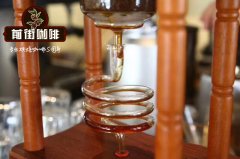Lattes can be delicious without milk: plant milk coffee is in vogue.
Professional coffee knowledge exchange more coffee bean information please follow the coffee workshop (Wechat official account cafe_style)
Lattes are widely loved, but some people can't drink or choose not to drink milk because of lactose intolerance, vegan diet, environmental protection, health care and other reasons, but still want to enjoy frankincense coffee, what to do?
In this regard, some coffee shops will provide plant milk as an alternative. In the past, the most common item was soy milk or soy milk, until vegan business opportunities rose in recent years, with the global sales of dairy alternative drinks rising, with more and more choices, such as almond milk, coconut milk, quinoa milk, pea milk, oat milk and so on. The alternative dairy market is expected to reach $18 billion this year, up 3.5 per cent from last year, according to Euromonitor research. However, compared with the milk market with a market size of nearly 120 billion, the proportion is less than two Chengdu, indicating great potential in the future.

Vegetable Milk Coffee: from soy milk, almond milk to oatmeal milk
Looking at the coffee industry in the past decade, we will find that the plant milk mainly used in the industry is constantly changing.
First of all, soybean milk. The Chinese began to produce soy milk as early as the 14th century, but it was not until the late 1990s in Europe and the United States that soy milk became a hit when food manufacturer WhiteWave launched a frozen soy milk called Silk. If Starbucks, a well-known chain brand, is used as a reference to observe the trend of the coffee market, soy milk lattes were launched in the United States in 2000, and have been listed in Japan and China within a few years. However, the distinct flavor of soy milk is easy to mask the taste of coffee itself, and some soy milk is easy to agglomerate after adding coffee, and the effect of dispelling milk foam is not thicker than milk. Not everyone is used to it, and coffee shops are not necessarily willing to use it. In addition, in recent years, soybeans have problems of genetic modification and estrogen, and their possible harm to health also makes consumers have doubts.
Almond milk rises accordingly. In 2008, Blue Diamond Growers, a large agricultural partnership made up of California almond farmers, sensed an opportunity in the soy milk controversy and put its almond milk, called Almond Breeze, on refrigerated shelves. Coincidentally, California almond industry launched a large-scale marketing campaign, the major media have also listed almonds as "super food", almond milk successfully grabbed the market. In 2013, almond milk officially replaced soy milk as the highest-selling plant milk in the United States.
After the trend of almond milk began to blow in the United States, independent cafes began to put almond milk on the menu. For example, the famous New York store Cafe integral launched almond sesame milk, and the new almond Hawaiian soy milk latte launched by Los Angeles Cafe Go Get Em Tiger and GambiB Coffee was praised by the New York Times as "the best latte in the country." Then Starbucks, Blue bottle Coffee (Blue Bottle) and other well-known chains have also put almond milk on the menu.
However, as if the feng shui turns, almond milk later also broke out the waste water problem. Even though almond milk still holds the top spot in the US vegetable milk market with a 64 per cent market share, oatmeal milk is catching up with 50 per cent annual turnover, according to market research firm Mintel Mintel. In addition, on the image community website Pinterest, the number of searches for oatmeal milk has also increased by 186% compared with last year, coupled with baristas' certification of its flavor, texture and environmental protection requirements, it has become a category with great potential for development in the vegetable milk market.
Focus on boutique coffee market: Swedish brand Oatly set off a trend of oatmeal milk
Among them, the Swedish brand Oatly is the first choice for baristas, and its charm sweeps the boutique cafes in Europe, America and Asia, setting off a trend of oatmeal milk.
Although it has only been popular all over the world in the past two years, Oatly is an old brand with a history of 25 years. Founded in 1994 by professors Karl Ove Knausgaard and Rickard Oste of Lund University in Sweden, after studying lactose intolerance, they decided to look for dairy products that are more suitable for humans than "milk". So using Sweden's rich oats as raw materials, using patented enzymatic hydrolysis technology to decompose starch, converting oats into liquid oat milk, retaining rich soluble dietary fiber, and adding rapeseed oil to replace cream taste, cultivate a small group of loyal customers without spending too much effort on marketing.
Until 2012, Tony Peterson, the new CEO, rebuilt the brand image from the inside out, focusing on environmental friendliness, chanting "It's like milk,but made for humans." and "Post Milk Generation" slogans, shaping a lifestyle that is "good for the earth" to drink oatmeal milk. In addition, the outer box has been redesigned to match the black-and-white pattern with a soft color, and the brand belief has been expressed on the packaging, attracting lactose intolerance, vegetarians and environmentalists. It has successfully marketed its products in more than 30 countries around the world and gained a reputation in the European market.
However, the real frenzy of Oatly can be said to be after entering the United States in early 2017. Because "oatmeal milk is a brand new commodity for Americans." So Oatly changed its marketing strategy: not to launch products on supermarket shelves, but to break into boutique cafes, hoping to use the power of baristas to let more consumers know and try oatmeal milk with people in the coffee circle.
According to this strategy, Oatly featured a "OATLY-Barista Coffee Master version" designed for coffee, which was successfully loved by many baristas, and well-known boutique cafes Intelligentsia and La Colombe were adopted one after another. later, in just one year, Oatly has expanded from 10 cafes in New York to more than 1000 in the United States. After the popularity, demand far exceeded supply, Oatly broke out of stock, at one point on Amazon even a can as high as $25 (about 177.8 yuan), as high as three times the retail price.
Today, Oatly covers more than 3000 boutique cafes in the United States, and as many as 3500 cafes in the UK use the brand oatmeal milk. In addition, it also officially entered the mainland China and Hong Kong markets at the beginning of 2018. in just over a year, 1300 to 1500 boutique cafes in mainland China have adopted Oatly, while there are more than 320 in Hong Kong-with a coverage of 80%. Until the beginning of this year, Oatly has officially entered Taiwan. In half a year, 150 cafes have put Oatly on the menu, and many famous coffee shops such as Goodmans Coffee, Fika Fika, VWI By Chadwang and so on.
After Oatly became famous in the boutique coffee circle, well-known coffee chains such as Starbucks and Pacific Coffee also began to use the oatmeal milk, and Blue Bottle, which is known as the Apple of the boutique coffee world, also replaced the original almond milk with Oatly. After laying a solid foundation in the coffee shop access, Oatly has also entered the shelves of major supermarkets, such as Whole Foods, Costco, and so on, opening retail channels. In addition, Oatly continues to expand factories in New Jersey, Utah and the Netherlands to meet the huge demand.
Many well-known food companies such as Danone's plant milk brand Silk and Pepsi's Quaker Oat have launched similar products to seize the market. According to Nielsen, a market survey agency, the annual turnover of oat milk grew by as much as 50% as of last August, far exceeding 9% of the overall market for vegetable milk and 11% of almond milk, which became popular three or four years ago. It can be said to be one of the most popular plant milk in recent years, sweeping caf é s in London, New York, Shanghai, Hong Kong, Taipei and other major cities.
END
Important Notice :
前街咖啡 FrontStreet Coffee has moved to new addredd:
FrontStreet Coffee Address: 315,Donghua East Road,GuangZhou
Tel:020 38364473
- Prev

The mystery of the cause of death of a cup of coffee-bitter and astringent coffee, who killed it?
Professional coffee knowledge exchange more coffee bean information please follow the coffee workshop (Wechat official account cafe_style) "this cup of coffee is too astringent / bitter", you often hear, meaning that "brewing" technology needs to be strengthened. But this is bullshit. Chicken and beef are tough because the parts we choose are different in meat quality, but we don't use a suitable cooking method.
- Next

How do you make espresso? How do you make an espresso at home?
Professional coffee knowledge exchange more coffee bean information Please follow the coffee workshop (Wechat official account cafe_style) when we went to a cafe, we saw on the menu that the cheapest coffee was often Espresso, or espresso. What is this espresso? How can you get an espresso at home? Concentrated oil is a mixture of many substances: water
Related
- Beginners will see the "Coffee pull flower" guide!
- What is the difference between ice blog purified milk and ordinary milk coffee?
- Why is the Philippines the largest producer of crops in Liberia?
- For coffee extraction, should the fine powder be retained?
- How does extracted espresso fill pressed powder? How much strength does it take to press the powder?
- How to make jasmine cold extract coffee? Is the jasmine + latte good?
- Will this little toy really make the coffee taste better? How does Lily Drip affect coffee extraction?
- Will the action of slapping the filter cup also affect coffee extraction?
- What's the difference between powder-to-water ratio and powder-to-liquid ratio?
- What is the Ethiopian local species? What does it have to do with Heirloom native species?

